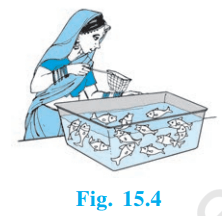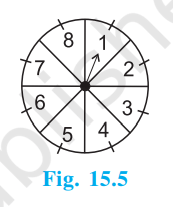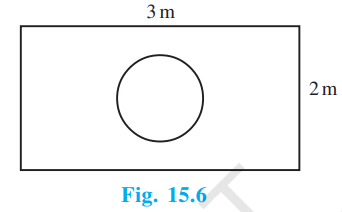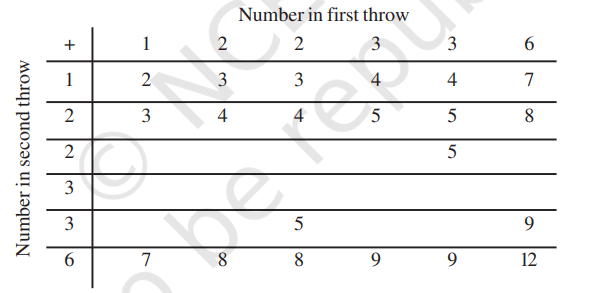NCERT Solutions Class 10th Maths Chapter 15: ProbabilityExercise 15.11. Complete the following statements:
SOLUTION
2. Which of the following experiments have equally likely outcomes? Explain.
SOLUTION
3. Why is tossing a coin considered to be a fair way of deciding which team should get the ball at the beginning of a football game? SOLUTION Tossing a coin has only two outcomes: Heads or Tails. The probability of any one outcome is equal to the other; hence the coin toss is a fair way of deciding which team should get the ball at beginning of a football game. 4. Which of the following cannot be the probability of an event? (A) 2/3 (B) -1.5 (C) 15% (D) 0.7 SOLUTION We know that probability of an event can only be between 0 and 1. 0 < (A) < 1, so it can the probability of an event. Similarly, (C) and (D) can also be the probability of an event. (B) < 0 < 1, so it cannot the probability of an event. 5. If P(E) = 0.05, what is the probability of 'not E'? SOLUTION It is known that P(E) + P(not E) = 1. Therefore, P(not E) = 1 - P(E) = 1 - 0.05 = 0.95 Hence, P(not E) = 0.95 6. A bag contains lemon flavoured candies only. Malini takes out one candy without looking into the bag. What is the probability that she takes out
SOLUTION
7. It is given that in a group of 3 students, the probability of 2 students not having the same birthday is 0.992. What is the probability that the 2 students have the same birthday? SOLUTION Let the event of 2 students not having the same birthday be denoted by E. P(E) + P(not E) = 1 P(not E) = 1 - P(E) = 1 - 0.992 = 0.008 Hence, the probability of 2 students having the same birthday is 0.008. 8. A bag contains 3 red balls and 5 black balls. A ball is drawn at random from the bag. What is the probability that the ball drawn is (i) red ? (ii) not red? SOLUTION Total number of balls in the bag = 3 + 5 = 8 Number of red balls = 3 P(a red ball is drawn) = Number of red balls/Total number of balls = 3/8 P(a red ball is drawn) + P(a red ball is not drawn) = 1 P(a red ball is not drawn) = 1 - P(a red ball is drawn) P(a red ball is not drawn) = 1 - 3/8 = 5/8 Hence, probability that a ball drawn at random is red = 3/8 and that of not red = 5/8. 9. A box contains 5 red marbles, 8 white marbles and 4 green marbles. One marble is taken out of the box at random. What is the probability that the marble taken out will be (i) red ? (ii) white ? (iii) not green? SOLUTION Total number of marbles in the box = 5 + 8 + 4 = 17 Number of red marbles = 5 (i) P(marble taken out is red) = Number of red marbles/Total number of marbles = 5/17 Number of white marbles = 8 (ii) P(marble taken out is white) = Number of white marbles/Total number of marbles = 8/17 Number of green marbles = 4 Number of marbles which are not green = 17 - 4 = 13 (iii) P(marble taken out is not green) = Number of marbles which are not green/Total number of marbles = 13/17 10. A piggy bank contains hundred 50p coins, fifty Rs 1 coins, twenty Rs 2 coins and ten Rs 5 coins. If it is equally likely that one of the coins will fall out when the bank is turned upside down, what is the probability that the coin (i) will be a 50 p coin? (ii) will not be a Rs 5 coin? SOLUTION Total number of coins in the piggy bank = 100 + 50 + 20 + 10 = 180 Number of 50p coins = 100 (i) P(the coin falling out is 50p coin) = Number of 50p coins/Total number of coins = 100/180 = 5/9 Number of Rs 5 coins = 10 Number of coins that are not Rs 5 = 180 - 10 = 170 (ii) P(the coin falling out is not Rs 5 coin) = Number of coins that are not Rs 5/Total number of coins = 170/180 = 17/18 11. Gopi buys a fish from a shop for his aquarium. The shopkeeper takes out one fish at random from a tank containing 5 male fish and 8 female fish (see Fig. 15.4). What is the probability that the fish taken out is a male fish? 
SOLUTION Total number of fish in the tank = 5 + 8 = 13 Number of male fish in the tank = 5 P(the fish taken out is male) = Number of male fish/Total number of fish = 5/13 12. A game of chance consists of spinning an arrow which comes to rest pointing at one of the numbers 1, 2, 3, 4, 5, 6, 7, 8 (see Fig. 15.5 ), and these are equally likely outcomes. What is the probability that it will point at

SOLUTION (i) P(arrow points at 8) = Favourable outcome/Total outcomes = 1/8 (ii) P(arrow points at an odd number) = Odd numbered outcomes/Total outcomes = 4/8 = 1/2 (iii) P(arrow points at a number greater than 2) = Number of outcomes greater than 2/Total outcomes = 6/8 = 3/4 (iv) P(arrow points at a number less than 9) = Number of outcomes less than 9/Total outcomes = 8/8 = 1 This is a sure event. 13. A die is thrown once. Find the probability of getting (i) a prime number; (ii) a number lying between 2 and 6; (iii) an odd number. SOLUTION Possible outcomes when a die is thrown once = 1, 2, 3, 4, 5, 6 (i) P(getting a prime number) = Number of Prime numbers on a die/Total outcomes = 3/6 = 1/2 (ii) P(getting a number between 2 and 6) = Number of outcomes between 2 and 6/Total outcomes = 3/6 = 1/2 (iii) P(getting an odd number) = Number of odd numbers/Total outcomes = 3/6 = 1/2 14. One card is drawn from a well-shuffled deck of 52 cards. Find the probability of getting
SOLUTION I. Number of kings of red color in the deck = 2 P(getting a king of red color) = Favourable outcomes/Total outcomes = 2/52 = 1/26 II. Number of face cards in the deck = 12 P(getting a face card) = Number of face cards/Total cards = 12/52 = 3/13 III. Number of red face cards in the deck = 6 P(getting a red face card) = Number of red face cards/Total cards = 6/52 = 3/26 IV. P(getting the jack of hearts) = 1/52 V. Number of spade cards in the deck = 13 P(getting a spade) = Number of spade cards/Total cards = 13/52 = 1/4 VI. P(getting the queen of diamonds) = 1/52 15. Five cards?the ten, jack, queen, king and ace of diamonds, are well-shuffled with their face downwards. One card is then picked up at random.
SOLUTION I. Total possible outcomes = 5 P(drawing the queen) = 1/5 II. Total possible outcomes after the queen is put aside = 5 - 1 = 4 (a) P(drawing an ace) = 1/4 (b) P(drawing a queen) = 0/4 Drawing a queen is an impossible event. 16. 12 defective pens are accidentally mixed with 132 good ones. It is not possible to just look at a pen and tell whether or not it is defective. One pen is taken out at random from this lot. Determine the probability that the pen taken out is a good one. SOLUTION Total number of pens = 12 + 132 = 144 Number of good pens = 132 P(a good pen is taken out) = Number of good pens/Total pens = 132/144 = 11/12 17.
SOLUTION I. Total number of bulbs = 20 Number of defective bulbs = 4 P(drawn bulb is defective) = Number of defective bulbs/Total number of bulbs = 4/20 = 1/5 II. Total number of bulbs left = 20 - 1 = 19 Number of non-defective bulbs left = 19 - 4 = 15 P(drawn bulb is not defective) = Number of defective bulbs/Total number of bulbs = 15/19 18. A box contains 90 discs which are numbered from 1 to 90. If one disc is drawn at random from the box, find the probability that it bears
SOLUTION I. Number of discs with a two-digit number = 81 (10 to 90) P(drawn disc bears a two-digit number) = Favourable outcomes/Total outcomes = 81/90 = 9/10 II. Number of discs with a perfect square number = 9 (Square of 1 to 9 are all smaller than 90) P(drawn disc bears a perfect square number) = 9/90 = 1/10 III. Number of discs with a number divisible by 5 = 18 (90/5 = 18, so 1 to 90 has 18 such numbers) P(drawn disc bears a number divisible by 5) = 18/90 = 1/5 19. A child has a die whose six faces show the letters as given below: 
The die is thrown once. What is the probability of getting (i) A? (ii) D? SOLUTION Total number of faces on the die = 6 (i) Number of faces with A on the die = 2 P(getting A on the die) = 2/6 = 1/3 (ii) Number of faces with D on the die = 1 P(getting D on the die) = 1/6 20. Suppose you drop a die at random on the rectangular region shown in Fig. 15.6. What is the probability that it will land inside the circle with diameter 1 m? 
(Not from examination point of view as stated in the NCERT) SOLUTION Radius of the circle = 1/2 = 0.5 m Area of the circle = ?r2 = 22/7 × 0.5 × 0.5 = 5.5/7 m2 Area of the rectangular region = length × breadth = 3 × 2 = 6 m2 P(the die lands inside the circle) = Area of circle/Area of the rectangular region = 5.5/7 × 1/6 = 0.131 21. A lot consists of 144 ball pens of which 20 are defective and the others are good. Nuri will buy a pen if it is good, but will not buy if it is defective. The shopkeeper draws one pen at random and gives it to her. What is the probability that
SOLUTION Total number of pens = 144 Number of defective pens = 20 Number of non-defective pens = 144 - 20 = 124 I. Nuri will only buy the pen if it is not defective. Therefore, P(she will buy the pen) = P(drawn pen is not defective) = Number of non-defective pens/Total pens = 124/144 = 31/36 II. P(she will not buy the pen) = 1 - P(she will buy the pen) = 1 - 31/36 = 5/36 22. Refer to Example 13. (i) Complete the following table: 
(ii) A student argues that 'there are 11 possible outcomes 2, 3, 4, 5, 6, 7, 8, 9, 10, 11 and 12. Therefore, each of them has a probability 1/11. Do you agree with this argument? Justify your answer. SOLUTION Possible outcomes on 2 dice : (1, 1), (1, 2), (1, 3), (1, 4), (1, 5), (1, 6) (2, 1), (2, 2), (2, 3), (2, 4), (2, 5), (2, 6) (3, 1), (3, 2), (3, 3), (3, 4), (3, 5), (3, 6) (4, 1), (4, 2), (4, 3), (4, 4), (4, 5), (4, 6) (5, 1), (5, 2), (5, 3), (5, 4), (5, 5), (5, 6) (6, 1), (6, 2), (6, 3), (6, 4), (6, 5), (6, 6) Total possible outcomes = 36 (i) Number of outcomes with sum 3 = 2 P(rolling the sum 3 on 2 die) = 2/36 = 1/18 Number of outcomes with sum 4 = 3 P(rolling the sum 4 on 2 die) = 3/36 = 1/12 Number of outcomes with sum 5 = 4 P(rolling the sum 5 on 2 die) = 4/36 = 1/9 Number of outcomes with sum 6 = 5 P(rolling the sum 6 on 2 die) = 5/36 Number of outcomes with sum 7 = 6 P(rolling the sum 7 on 2 die) = 6/36 = 1/6 Number of outcomes with sum 9 = 4 P(rolling the sum 9 on 2 die) = 4/36 = 1/9 Number of outcomes with sum 10 = 3 P(rolling the sum 10 on 2 die) = 3/36 = 1/12 Number of outcomes with sum 11 = 2 P(rolling the sum 11 on 2 die) = 2/36 = 1/18 Completed table will be:
(ii) As shown above there are a total of 36 possible outcomes for this event. Hence, the statement made by the student is incorrect. 23. A game consists of tossing a one rupee coin 3 times and noting its outcome each time. Hanif wins if all the tosses give the same result i.e., three heads or three tails, and loses otherwise. Calculate the probability that Hanif will lose the game. SOLUTION Possible outcomes on 3 coin tosses : HHH, HHT, HTH, HTT, THH, THT, TTH, TTT Total outcomes = 8 Hanif will win the game if the outcome is HHH or TTT. P(Hanif will lose) = 1 - P(Hanif will win) = 1 - 2/8 = ¾ Hence, the probability that hanif will lose the game is 3/4. 24. A die is thrown twice. What is the probability that (i) 5 will not come up either time? (ii) 5 will come up at least once? [Hint : Throwing a die twice and throwing two dice simultaneously are treated as the same experiment] SOLUTION Possible outcomes on 2 dice throws: (1, 1), (1, 2), (1, 3), (1, 4), (1, 5), (1, 6) (2, 1), (2, 2), (2, 3), (2, 4), (2, 5), (2, 6) (3, 1), (3, 2), (3, 3), (3, 4), (3, 5), (3, 6) (4, 1), (4, 2), (4, 3), (4, 4), (4, 5), (4, 6) (5, 1), (5, 2), (5, 3), (5, 4), (5, 5), (5, 6) (6, 1), (6, 2), (6, 3), (6, 4), (6, 5), (6, 6) Total possible outcomes = 36 (i) Number of outcomes without 5 = 25 P(5 does not come up either time) = 25/36 (ii) P(5 comes up at least once) = 1 - P(5 does not come up either time) = 1 - 25/36 = 11/36 25. Which of the following arguments are correct and which are not correct? Give reasons for your answer.
SOLUTION I. Possible outcomes when 2 coins are tossed: (H, H), (H,T), (T,H), (T,T) Total outcomes = 4 Number of outcomes with both head and tails = 2 P(getting both Heads and Tails) = 2/4 = 1/2 Therefore, the given statement is incorrect. II. Possible outcomes when a die is thrown: 1, 2, 3, 4, 5, 6 Total outcomes = 6 Number of outcomes with an odd number = 3 P(getting an odd number) = 3/6 = 1/2 Therefore, the given statement is true. Exercise 15.2 (Optional)1. Two customers Shyam and Ekta are visiting a particular shop in the same week (Tuesday to Saturday). Each is equally likely to visit the shop on any day as on another day. What is the probability that both will visit the shop on (i) the same day? (ii) consecutive days? (iii) different days? SOLUTION Possible outcomes when Shyam and Ekta visit the shop in the same week: (T, T), (T, W), (T, Th), (T, F), (T, S) (W, T), (W, W), (W, Th), (W, F), (W, S) (Th, T), (Th, W), (Th, Th), (Th, F), (Th, S) (F, T), (F, W), (F, Th), (F, F), (F, S) (S, T), (S, W), (S, Th), (S, F), (S, S) [T = Tuesday, W = Wednesday, Th = Thursday, F = Friday, and S = Saturday] Total outcomes = 25 I. Number of outcomes where both visit on the same day = 5 P(they visit the shop on the same day) = 5/25 = 1/5 II. Number of outcomes where both visit on consecutive days = 8 P(they visit the shop on consecutive days) = 8/25 III. Number of outcomes where both visit on different days = 20 P(they visit the shop on different days) = 20/25 = 4/5 2. A die is numbered in such a way that its faces show the numbers 1, 2, 2, 3, 3, 6. It is thrown two times and the total score in two throws is noted. Complete the following table which gives a few values of the total score on the two throws: 
What is the probability that the total score is (i) even? (ii) 6? (iii) at least 6? SOLUTION Completed table will be:
Total outcomes = 36 (i) Number of outcomes with even score = 18 P(getting even score) = 18/36 = 1/2 (ii) Number of outcomes with score of 6 = 4 P(getting score of 6) = 4/36 = 1/9 (iii) Number of outcomes with score of at least 6 = 9 P(getting a score of at least 6) = 9/36 = 1/4 3. A bag contains 5 red balls and some blue balls. If the probability of drawing a blue ball is double that of a red ball, determine the number of blue balls in the bag. SOLUTION Let the number of blue balls in the bag be x Total number of balls in the bag = 5 + x P(drawing a red ball) × 2 = P(drawing a blue ball) 5/(5 + x) × 2 = x/(5 + x) 10 = x Therefore, the bag contains 10 blue balls. 4. A box contains 12 balls out of which x are black. If one ball is drawn at random from the box, what is the probability that it will be a black ball? If 6 more black balls are put in the box, the probability of drawing a black ball is now double of what it was before. Find x. SOLUTION Total number of balls in the box = 12 Number of black balls = x P(drawing a black ball) = x/12 Total number of balls in the box when 6 black balls are added = 12 + 6 = 18 Number of black balls when 6 are added = x + 6 P(drawing a black ball) × 2 = P(drawing a black ball after adding 6 black balls) x/12 × 2 = (x + 6)/18 3x = x + 6 2x = 6 x = 3 Hence, there were originally 3 black balls in the bag. 5. A jar contains 24 marbles, some are green and others are blue. If a marble is drawn at random from the jar, the probability that it is green is 2/3. Find the number of blue balls in the jar. SOLUTION Let the number of green marbles in the jar be x. Then the number blue marbles = 24 - x Total number of marbles in the jar = 24 P(drawing a green marble) = 2/3 x/24 = 2/3 x = 16 Number of green marbles = 16 Hence, number of blue marbles = 24 - 16 = 8
Next TopicNCERT Solutions Class 10 Science
|
 For Videos Join Our Youtube Channel: Join Now
For Videos Join Our Youtube Channel: Join Now
Feedback
- Send your Feedback to [email protected]
Help Others, Please Share









